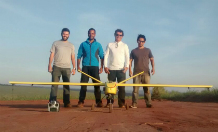
The drone has been tested in South America.
New drone technology will uncover secrets of Amazonian tribes
Experts hope to uncover the hidden secrets of ancient Amazon tribes and their effect on modern vegetation using revolutionary new drone technology.
Researchers from the University of Exeter will survey the largest rainforest in the world, in collaboration with the National Institute for Space Research in Brazil, using the remotely piloted aircraft to find out more about how people thousands of years ago used these forests.
They hope to answer questions about the impact of past humans on the Amazon forest. It is not yet known how the small bands of hunter-gatherers who have lived there transformed the landscape, or how complex their society was.
The Amazon plays an essential role in global climate and carbon cycle regulations. Humans have lived there for 13,000 years. It has previously been assumed they had a negligible impact, but there is growing evidence to suggest this was not the case.
The results of the project will reveal the nature and scale of changes made by ancient humans on the Amazon.
A team will fly a fixed-wing remotely piloted aircraft around the Amazon basin next month. They have worked with aerospace experts, engineers, and technicians to construct one of the first fixed-wing drones attached with a high quality, survey grade laser device.
The laser will scan the landscape, collecting 3D data which will show how humans altered the landscape. The 3D images will help identify where archaeological digs should take place, otherwise a difficult task because the lush vegetation of the Amazon obscures the landscape.
The equipment has been built and tested successfully during the last year in Brazil, and the drone flights will take place this October.
Remote Sensing experts from University of Exeter built and tested the equipment with the expertise of the Brazilian National Institute for Space Research and the RPA manufacturers XMobots.
The project, called PAST, Pre-Columbian Amazon Scale Transformations, will not only give valuable information on how resilient the Amazon is, but also inform policy on how the rainforest can be used in a sustainable manner.
Dr Salman Khan, from the University of Exeter, a remote sensing expert on the team, said: “We have been testing the drone in Sao Paulo state in Brazil and it can fly and collect data for two and half hours covering an area of roughly 60 square km.
“We believe it has not been possible until now to attach a survey quality laser scanner on a drone that can fly for such a long time, so this is a feat of engineering which will allow us to collect data of huge significance over the vast Amazon.
“The laser scanner sends signals to the ground, and records the reflections, which allows us to produce a 3D model of the terrain. We can then remove the covering of vegetation using sophisticated algorithms to reveal the ground below.
“We are ready to go to the Amazon this October to to find out how the ancient humans lived.”
Find out more on the PAST project website.
Date: 9 September 2016
